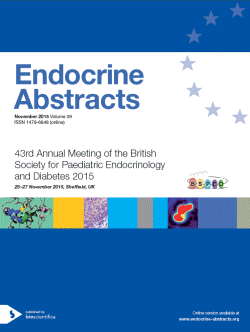Searchable abstracts of presentations at key conferences in endocrinology

Society for Endocrinology BES 2015
Edinburgh,
UK
02 Nov 2015 - 04 Nov 2015

2-4 November 2015, Edinburgh, UK
Further information
ea0038se1.1 | (1) | SFEBES2015
The new tachykinin, endokinin: its role in emesis, sialorrhea and smoking in pregnancy
The human tachykinin, endokinin (EK), is processed into a 41mer in the human placenta. As synthetic EK(1041) is as potent as substance P at the NK1R, it is likely that the primary function of EK is as the principal placental NK1R agonist mediating local beneficial vasodilatation. Although the emetic and sialogogic actions of substance P are well known, its complete absence from the placenta probably explains why its role in pregnancy has not been studie...
ea0038se1.3 | (1) | SFEBES2015
Steroid mass spectrometry: a 50 year history
The characterization and measurement of steroids in health and disease has been a cornerstone of endocrinology since the 1930s. The first example of a diagnostic steroid for an endocrine disorder was the discovery of pregnanetriol in the urine of patients with the adrenogenital syndrome (CAH) by Guy Marrian in 1937. He went on to head the Clinical Endocrinology Research unit in Edinburgh for many years. For decades, paper and TLC dominated metabolomic (urinary steroid) approac...
ea0038se1.4 | (1) | SFEBES2015
A crackpot ejection theory about China’s unique natural glass
An interest in art and antiques and a chance discovery in Hong Kong in 2000 led rapidly to an obsession with carvings from Northern Chinas 5000 year old Hongshan Culture. The most controversial are in a unique silica glass (shui jing), with a very high melting temperature (>1600 °C) and no additives or stabilisers, that could only have originated from a large unique meteorite impact. This paper will present results on the carvings of light microscopy...
ea0038se1.5 | (1) | SFEBES2015
Understanding the biochemistry underpinning hypoglycaemia of the insulin autoimmune syndrome (IAS) is paramount for diagnosis and management
IAS is common in Japanese but rare in Caucasians. Highlighting its aetiology is paramount in understanding its clinical and analytical variabilities and can help planning investigations and avoid mistakes in the interpretation of false pancreatic endocrine data commonly associated with this syndrome.The underlying aetiology of IAS is the presence of high affinity/avidity endogenous insulin autoantibodies in significant amounts in non-diabetics. Clinicall...



